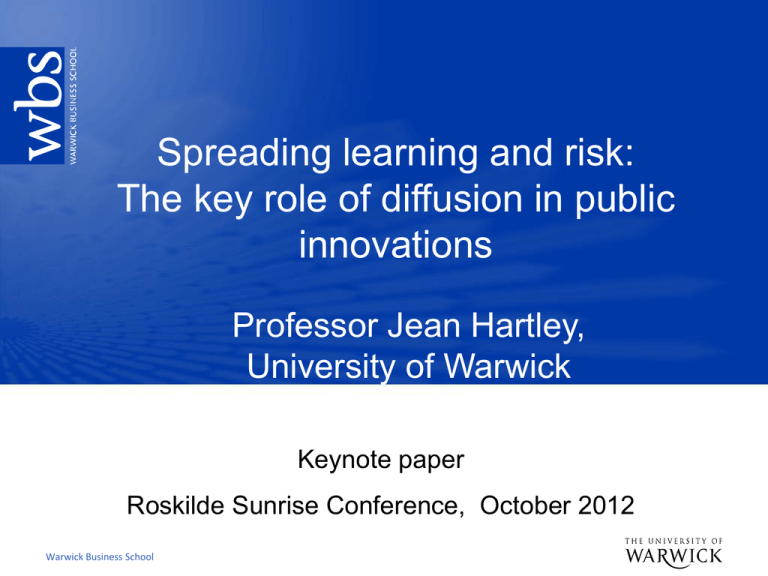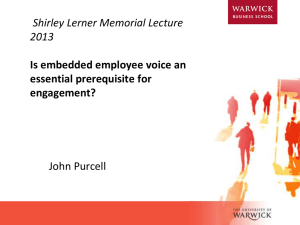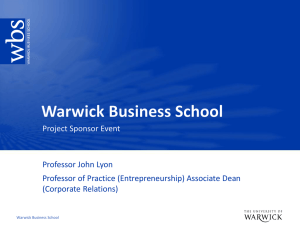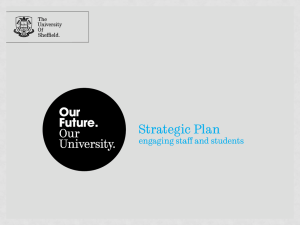The Beacon Scheme where next in a changing landscape?
advertisement

Spreading learning and risk: The key role of diffusion in public innovations Professor Jean Hartley, University of Warwick Keynote paper Roskilde Sunrise Conference, October 2012 Warwick Business School The overall argument Diffusion has been under-emphasised in research on public and collaborative innovation It can be an effective way to mitigate risk, share learning and reduce resource expenditure Diffusion requires organizational and inter-organizational learning to build organizational capacity and policy learning. Learning develops over time Empirical research over 9 years with whole population of English local government Research shows shift from learning to imitate to learning to innovate Warwick Business School Warwick Business School Public and private innovation (Hartley, in press) Lot to learn across sectors Variation within as well as across sectors BUT 1. 2. 3. 4. 5. 6. Pressures for innovation not primarily competition but changing needs in society (though context changing e.g. foundation hospitals and schools) Public organizations and networks not the private firm as the primary unit of analysis Role of politicians and policy advisors in catalysing innovation – need to deal with more than one source of innovation and different processes of innovation Service innovations have different features from product innovations The “public value” test of innovation’s role in improvement (cf Benington and Moore) Diffusion of innovation critical for public service organizations, and based in relatively open networks not closed alliances Warwick Business School Three analytical stages of innovation Implementation Invention Warwick Business School 13/04/2015 6 Diffusion Diffusion of innovation In the private sector, innovation is a source of competitive advantage – so little voluntary sharing with competitors (only in closed networks of partners) For the public sector, innovation is valuable where it leads to improvements not only in the organization but across the field (e.g. hospitals) and even across sector – advantage to sharing between organizations Warwick Business School The diffusion of innovation A key source of innovation for public services is the spreading of ‘good’, ‘promising’ and ‘next’ practice within and between organizations Warwick Business School Innovation is defined as being new to the organization/partnership or users deploying it (West, 1990; Lynn, 1997) Miranda: O brave new world that has such people in it!' Prospero: `Tis new to thee The Tempest (Shakespeare) (and courtesy of Chris Yapp) Warwick Business School Bringing innovation in to the organization or collaborative partnership Harvesting ideas from outside as well as inside the organization eg. open innovation Recombinant innovation – an idea or practice originally used for a different purpose or in a different context Diffusion of innovation – taking existing innovations and (generally) adapting them for use within a particular context and culture Collaborative innovation – sharing ideas and practices across partnership Warwick Business School Diffusion of innovation – 2004 national survey in UK local government (n = 448 leaders and managers) (Hartley et al, 2007) Taking ideas and implementing them from high performers/innovators in the Beacon Scheme in local government: 63% adapted a Beacon idea This shows that adaption rather than adoption occurs 29% accelerated implementation of an existing idea Acceleration – attributional bias? But also interviews reported that it reduced risk; helped with confidence; helped to mobilise support; argument to others they would be left behind; avoiding mistakes and dead-ends; building on what already done 8% based improvement closely on the Beacon Replication rarely occurs (Behn, 2008) except in near-lab conditions Warwick Business School If diffusion can be important, how does it occur? Diffusion rarely replication or adoption – lot of adaption and acceleration – both involve learning Either the idea/practice itself, or to suit a particular context/culture/budget/political orientation Requires a theory of organizational and interorganizational learning Will explore this in a 9 year empirical research study in local government Warwick Business School Organizational knowledge and learning Overlapping and interconnected literatures (EasterbySmith et al 2000; Crossan et al 2011). Some integrative approaches (Chiva and Alegre 2005) unite the cognitive-process perspective and social–process perspective. Organizational (and inter-organizational) learning defined as a socially constructed and contextually embedded collective practice, underpinned by concepts of explicit and tacit knowledge (Polanyi 1966; Nonaka 1994). Warwick Business School Institutional context of change Institutional field emphasizes influences on learning of organizational environment, spatial and temporal factors (Pettigrew, Woodman and Cameron 2001). Much institutional theory tends to focus on pressure to conform – mimetic isomorphism, active copying (DiMaggio and Powell 1983). Critics argue isomorphism risks overlooking local, relational, political, and interactional factors (Haunschild and Chandler 2008). Warwick Business School Cumulative model of learning (Kim 1998) “All organizations are learning systems.” A crisis can play an important role in organizational learning leading to step change. Absorptive capacity: interplay of organization’s pre-existing knowledge base, and intensity of effort directed at learning to solve problems. Migratory knowledge enables tacit knowledge acquisition from another location. “Catching up” through sequences of learning. Warwick Business School Cumulative learning Iterative, dynamic and cumulative relationship over time between knowledge, learning and innovation. Organizational knowledge and learning are cumulative: a) A minimal prior knowledge base allows imitation b) A greater knowledge base permits creative adaptation c) An extensive knowledge base produces an innovative organization (Kim 1998) Warwick Business School Organizational learning PHASES OF LEARNING: IMITATION, ADAPTATION AND INNOVATION (adapted from Kim, 1998) Extent of prior knowledge increases capacity for next phase Phase 1 Duplicative imitation Warwick Business School Phase 2 Creative adaptation Phase 3 Innovation Empirical research over 9 years: the English Beacon Scheme Aim: A national initiative to improve performance of English local government (and some other local public services): 1. To provide national recognition to best performing local authorities (high performance or innovation) through a national annual competitive award in service themes 2. To share “best practice” (sic) to enable weak or mediocre local authorities to “learn from the best” and to improve Longest-standing policy instrument of reform of last Government but least commented on Warwick Business School Outline of the Beacon Scheme 1999 to 2009 Competitive award scheme open to all 388 English local authorities plus local public services e.g. police, fire, national parks, and passenger transport National Panel selects approximately 10 themes per year for awards, and decides on winners following application Applications can be single or joint Three criteria: excellent or innovative service in nominated theme; good overall corporate performance; plan to share good practice Awarded for one year Range of learning events Warwick Business School Warwick research methods 2001 national survey of all English local authorities (n=180 authorities, 47% response rate; n=314 responses from range of senior people) 2004 national survey of all English local authorities (n=191 authorities, 48% response rate; n=448 responses from range of senior people) 2006 national survey of all English local authorities (n=174 authorities, 45% response rate; n=360 responses from range of senior players) Front-line staff survey (n=1933 responses, 50% response rate across 15 councils) 30 intensive case studies of organizations, some over time Analysis of baseline and repeated performance measures Index for all 388 councils of involvement with the Beacon Scheme in terms of application, short list and award over 7 rounds of Scheme. Warwick Business School Key features of research design Longitudinal: over 9 years Data on the population (n=388) of English local authorities Beacons and non-Beacons (not biased towards innovators) Qualitative and quantitative Case study and surveys Multi-respondent i.e. elected members, strategic and operational managers, front-line staff, agency partners, and civil servants ‘Hard’ performance measures and ‘soft’ learning measures Robust data: high response rates and high quality data Very large data set Warwick Business School Evaluation and advice on Beacon Scheme policy Regular evaluation evidence and advice to Independent Advisory Panel for Beacon Scheme, and related government ministers Major contribution to 2008 policy review: “objective and reflective work” for reviewing scheme Warwick Business School Learning and innovation in the Beacon Scheme 1999-2008: three phases Warwick Business School The Beacon Scheme phase one (1999 – 2001): Duplicative imitation Mixed responses (sceptical to engaged) Dissemination emphasised achievement not how got to there Overlooked contextual factors and organizational processes Focus on “best practice” push by Beacons Only a few felt that they had learned a great deal (8%) Under-theorising of inter-organizational learning Failed to distinguish tacit and explicit knowledge Under-performing authorities lacked absorptive capacity Authorities with more extensive knowledge base benefited Warwick Business School The Beacon Scheme phase two (2001 – 2004): Adaptation Less experimental, more performance indicators in award (in tune with wider public service reform approach) More ambitious themes and inclusion of partners in award Scheme included innovation as a goal not just ‘best practice’ (though tension with performance indicators) More emphasis on how Beacons had innovated/improved their performance More preparation by learners before Beacon visits (indicating learning approach) Greater awareness of the value and methods of sharing learning as central to organizational change Interest in “learner pull” not just “Beacons push” Learning approach extended: tacit/explicit distinction; regional networks; peer mentoring; migratory knowledge. Active process of transfer of learning to local context: 63% adapted ideas Warwick Business School The Beacon Scheme phase three (2004 – 2008): Innovation Beacons seen as ‘gold standard’ of award schemes in UK Local government now widely involved either as Beacon or learner, or both. Greater interest in how to give awards to innovators (still tension with performance indicators) More policy learning between national and local government Modest increases in financing of scheme by national government More extensive education programme nationally on Beacons and learning More peer to peer focus (sharing learning rather than Beacons push) Tailored programmes of engagement more extensive More focus on innovation and how to support and sustain it. Interest in promising and next practice. Evidence of cumulative learning, adaptation and innovation at organizational and population levels 2006 survey – even higher levels of acceleration (46-68% cf 29% in 2004) Warwick Business School The role of learning in the diffusion of innovation In public and private sectors, organizational learning can be source of strategic renewal Research shows learning is socially created (role of migratory knowledge; trust; preference for peer to peer exchange) Cumulative learning over time leads to shifts in population level system Imitation Creative adaptation Innovation Warwick Business School Organizational learning PHASES OF LEARNING: IMITATION, ADAPTATION AND INNOVATION (adapted from Kim, 1998) Extent of prior knowledge increases capacity for next phase Phase 1 Duplicative imitation Warwick Business School Phase 2 Creative adaptation Phase 3 Innovation Conclusions: Innovation through diffusion and implications for collaborative innovation Based on detailed long-term research on all English local government: Diffusion is a crucial element of innovation for public bodies Diffusion of innovation involves adaption much more than adoption Diffusion supports the acceleration of existing ideas which can build confidence, reduce risk and build on existing knowledge Innovation crucially involves learning Organizations’ capacity to learn can develop over time. Engagement in new ideas and practices enhances ability to shift from imitation to innovation. All diffusion is collaborative to some extent; all collaboration involves sharing learning Warwick Business School










